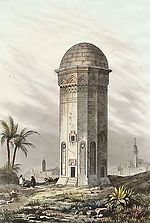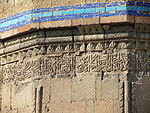Qara Qoyunlu
Kara Koyunlular Black Sheep Turkomans قره قویونلو | |||||||||
|---|---|---|---|---|---|---|---|---|---|
| 1374–1468 | |||||||||
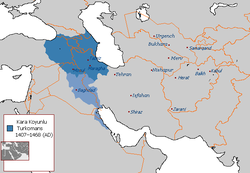 Kara Koyunlu of the Turkomans, lighter blue shows their greatest extent in Iraq and Arabian East Coast for a small period of time | |||||||||
| Capital | Tabriz | ||||||||
| Common languages |
| ||||||||
| Religion | Islam | ||||||||
| Government | Monarchy | ||||||||
| Ruler | |||||||||
• 1375–1378 | Bayram Xoca | ||||||||
• 1467–1468 | Hasan 'Ali | ||||||||
| Historical era | Middle Ages | ||||||||
• Established | 1374 | ||||||||
• Disestablished | 1468 | ||||||||
| |||||||||
| Today part of | |||||||||
| History of Azerbaijan |
|---|
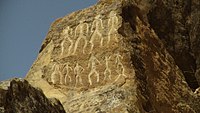 |
|
|
| History of Turkey |
|---|
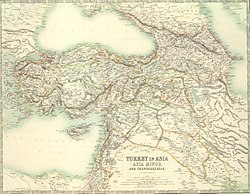 |
| Timeline |
|
|
| History of Iran |
|---|
 |
|
Timeline |
The Kara Koyunlu or Qara Qoyunlu, also called the Black Sheep Turkomans (Persian: قره قویونلو), were a Muslim Oghuz Turkic monarchy that ruled over the territory comprising present-day Azerbaijan, Georgia, Armenia (1406), northwestern Iran, eastern Turkey, and northeastern Iraq from about 1374 to 1468.[2][3]
History
The Kara Koyunlu Turkomans at one point established their capital in Herat in modern-day Afghanistan.[4] They were vassals of the Jalairid Sultanate in Baghdad and Tabriz from about 1375, when the leader of their leading tribe ruled over Mosul. However, they rebelled against the Jalairids, and secured their independence from the dynasty with the conquest of Tabriz by Qara Yusuf. In 1400, Timur defeated the Kara Koyunlu, and Qara Yusuf fled to Egypt, seeking refuge with the Mamluk Sultanate. He gathered an army and by 1406 had taken back Tabriz.
In 1410, the Kara Koyunlu captured Baghdad. The installation of a subsidiary Kara Koyunlu line there hastened the downfall of the Jalairids they had once served. Despite internal fighting among Qara Yusuf's descendants after his death in 1420, and the increasing threat of the Armenian separatists and Ajam, Kara Koyunlu later broke up due to series of different Armenian revolts.
Religion
According to R. Quiring-Zoche in the, Encyclopedia Iranica:
The argument that there was a clear-cut contrast between the Sunnism of the Āq Qoyunlū and the Shiʿism of the Qara Qoyunlū and the Ṣafawīya rests mainly on later Safavid sources and must be considered doubtful.[5]
C.E. Bosworth in, The New Islamic Dynasties, states:
As to the religious affiliations of the Qara Qoyunlu, although some of the later member of the family had Shi'i-type names and there were occasional Shi'i coin legends, there seems no strong evidence for definite Shi'i sympathies among many Turkmen elements of the time.[6]
Jahān Shāh
Jahan Shah made peace with the Timurid Shahrukh Mirza; however, this soon fell apart. When Shahrukh Mirza died in 1447, the Kara Koyunlu Turkomans annexed portions of Iraq and the eastern coast of the Arabian Peninsula as well as Timurid-controlled western Iran. Though much territory was gained during his rule, Jahān Shāh's reign was troubled by his rebellious sons and the almost autonomous rulers of Baghdad, whom he expelled in 1464. In 1466, Jahan Shah attempted to take Diyarbakır from the Aq Qoyunlu ("White Sheep Turkomans"), however, this was a catastrophic failure resulting in Jahān Shāh's death and the collapse of the Kara Koyunlu Turkomans' control in the Middle East. By 1468, at their height under Uzun Hasan (1452–1478), Aq Qoyunlu defeated the Qara Qoyunlu and conquered Iraq, Azerbaijan, and western Iran.[7]
Kara Koyunlu rule
Armenia
Armenia fell under the control of the Kara Koyunlu in 1410. The principal Armenian sources available in this period come from the historian Tovma Metsopetsi and several colophons to contemporary manuscripts.[8] According to Tovma, although the Kara Koyunlu levied heavy taxes against the Armenians, the early years of their rule were relatively peaceful and some reconstruction of towns took place. This peaceful period was, however, shattered with the rise of Qara Iskander, who reportedly made Armenia a "desert" and subjected it to "devastation and plunder, to slaughter, and captivity".[9] Iskander's wars with and eventual defeat by the Timurids invited further destruction in Armenia, as many Armenians were taken captive and sold into slavery and the land was subjected to outright pillaging, forcing many of them to leave the region.[10] Iskander did attempt to reconcile with the Armenians by appointing an Armenian from a noble family, Rustum, as one of his advisers.
When the Timurids launched their final incursion into the region, they convinced Jihanshah, Iskander's brother, to turn on his brother. Jihanshah pursued a policy of persecution against the Armenians in Syunik and colophons to Armenian manuscripts record the sacking of the Tatev monastery by his forces.[10] But he, too, sought a rapprochement with the Armenians, allotting land to feudal lords, rebuilding churches, and approving the relocation of the seat of the Armenian Apostolic Church's Catholicos to Etchmiadzin Cathedral in 1441. For all this, Jihanshah continued to attack Armenian towns and take Armenian captives as the country saw further devastation in the final years of Jihanshah's failed struggles with the Aq Qoyunlu.[11]
Mausoleum of Turkmen emirs
One of the most prominent monuments built by the Kara Koyunlu dynasty remains today in the vicinity of the Armenian capital, the Mausoleum of Kara Koyunlu emirs. Turkmenistan and Armenia both contribute to the restoration and preservation of this medieval piece of architecture.
Gallery
-
Erivan tower. 1838
-
Graveyard in Argavand, fragment in Arabic.
-
Graveyard in Argavand, fragment in Arabic.
See also
Notes
- ^ a b Minorsky 1954, p. 283.
- ^ Hovanissian 2004, p. 4.
- ^ Encyclopædia Britannica. "Kara Koyunlu". Online Edition, 2007
- ^ Patrick Clawson. Eternal Iran. Palgrave Macmillan. 2005 ISBN 1-4039-6276-6 p.23
- ^ Quiring-Zoche 2009.
- ^ Bosworth 1996, p. 274.
- ^ Stearns, Peter N.; Leonard, William (2001). The Encyclopedia of World History. Houghton Muffin Books. p. 122. ISBN 0-395-65237-5.
- ^ Kouymjian, Dickran (1997), "Armenia from the Fall of the Cilician Kingdom (1375) to the Forced Migration under Shah Abbas (1604)" in The Armenian People From Ancient to Modern Times, Volume II: Foreign Dominion to Statehood: The Fifteenth Century to the Twentieth Century, ed. Richard G. Hovannisian, New York: St. Martin's Press, p. 4. ISBN 1-4039-6422-X.
- ^ Kouymjian. "Armenia", p. 4.
- ^ a b Kouymjian. "Armenia", p. 5.
- ^ Kouymjian. "Armenia", pp. 6–7.
Works cited
- Bosworth, Clifford E. (1996). The New Islamic Dynasties. Columbia University Press.
{{cite book}}: Invalid|ref=harv(help) - Kouymjian, Dickran (2004). "Armenia from the fall of the Cilician Kingdom (1375) to the forced emigration under Shah Abbas". In Hovannisian, Richard G. (ed.). The Armenian People From Ancient to Modern Times, Volume I: The Dynastic Periods: From Antiquity to the Fourteenth Century. Palgrave Macmillan. ISBN 978-1-4039-6421-2.
{{cite book}}: Invalid|ref=harv(help) - Minorsky, V. (1954). "Jihān-Shāh Qara-Qoyunlu and His Poetry (Turkmenica, 9)". Bulletin of the School of Oriental and African Studies. 16 (2): 271–97. doi:10.1017/s0041977x00105981. JSTOR 609169.
{{cite journal}}: Invalid|ref=harv(help) - Quiring-Zoche, R. (2009-10-29). AQ QOYUNLŪ.
{{cite book}}: Invalid|ref=harv(help); Unknown parameter|encyclopedia=ignored (help)
Further reading
- Bosworth, Clifford. The New Islamic Dynasties, 1996.
- Template:Hy icon Khachikyan, Levon. ԺԵ դարի հայերեն ձեռագրերի հիշատակարաններ, մաս 1 (Fifteenth Century Armenian Colophons, Part 1). Yerevan, 1955.
- Morby, John. The Oxford Dynasties of the World, 2002.
- Sanjian, Avedis K. Colophons of Armenian manuscripts, 1301-1480: A Source for Middle Eastern History, Selected, Translated, and Annotated by Avedis K. Sanjian. Cambridge: Harvard University Press, 1969.
- Kara Koyunlu
- Empires and kingdoms of Iran
- Former countries in Western Asia
- Former countries in the Middle East
- Historical Turkic states
- Turkic dynasties
- Medieval Persia
- Medieval Iraq
- Medieval Azerbaijan
- Medieval Iranian Azerbaijan
- Medieval Armenia
- Medieval Islam
- 14th century in Asia
- 15th century in Asia
- States and territories established in 1375
- States and territories disestablished in 1468
- 1375 establishments in Asia
- 1468 disestablishments in Asia
- Former monarchies of Western Asia

